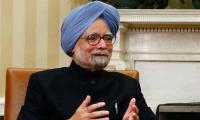ISLAMABAD: The current account is manageable when the economy grows at about 3 percent. It gets out of hand at a growth rate of 5 percent or so, especially with increased import of machinery to build production capacity. More importantly, the economy’s debt level grows by a higher margin in the years when the trade deficit is higher, unfolds the research report of IPR (Institute of Policy Reforms) on ‘What to do on Pakistan’s mountain of debt’.
The 41-page report builds its arguments based on information’s of State Bank of Pakistan, Economic Survey of Pakistan and IMF estimates about Pakistan’s economy on how to wriggle the country out of economic mess comprising unsustainable debt, unjustified surge in imports, vulnerable balance of payments and massive reliance on import of LNG to cater to energy needs of the country. It also comes up with a set of 11 proposed actions and 10 medium-term recommendations. If materialised, the economy can be put on the right path.
It mentions saying whenever Pakistan goes for higher growth and imports get increased it results in high trade deficit impacting the current account deficit adversely. The IPR research suggests that present structure of our economy cannot support a growth rate higher than 2pc to 3pc, arguing that when the economy grows by 2pc to 3pc, Pakistan’s exports and remittances are enough to meet most imports. But, when the economy grows by about 5pc, additional loans finance higher imports. That results in higher interest and amortisation payments and a current account crisis. The same happens when the price of essential imports, such as energy and food, suddenly increases. The sum of the economy’s infrastructure, human resource and institutional assets is good for the economy to grow by up to 3pc. Trouble arises when it wishes to grow at a higher rate. In short, the economy has not accumulated enough capital for high growth.
The IPR report, however, says that a growth rate of 2pc to 3pc is not an acceptable goal for the economy.
The IPR in its report also pinpoints how the government spends taxpayers’ money. Major chunk of the revenue, which is 38 percent, is spent on debt servicing, 19 percent on subsidies and grants, 18 on defence, 9 percent on PSDP, 7 percent on civil government and 6 percent on pensions.
“The government has been suggested to make special efforts to prevent re-entry of Afghan transit imports as these re-imports have done great damage to our manufacturing sector.”
It also recommends the government to earmark remittances to pay back loans, rather than just borrowing to repay. “Of course, money is fungible, but earmarking sets a clear target in the government’s mind to direct a certain amount towards debt repayment. Even 10pc would mean a reduction in debt by $3 billion. “Less foreign exchange available for import would force the government to curtail imports and find substitutes in Pakistan.”
In addition to a Saudi facility for deferred payment for oil, the IPR asks the government to seek the same from Qatar if the government has revived the long-term LNG contract. Energy exporters are windfall beneficiaries of recent hikes in the prices. The government may request Qatar for partial interest-free deferment of payments, or if possible, payment in rupees.
The IPR also reports that since FY2001, Pakistan has paid an average of $1.4 billion annually in interest alone. Average interest paid in the last four years is $2.7 billion annually for a total of $10.7 billion since FY18. Since FY2001, Pakistan has paid external creditors more than it has received from them. In 20 years, it has received $112.6 billion and paid back $118 billion in interest and principal. Yet, its external debt has grown by 228pc from $37.2 billion in FY01 to $122.2 billion in FY21. “We may have paid back the original loan more than once and still owe it to the creditor. This is because often the purpose of new loans is to repay past loans with the result that over 70pc of new debt is to meet balance of payments needs,” the IPR search report reveals.
According to the IPR, average debt tenor has reduced and cost of borrowing increased. During the period of 2010-2021, the share of low-cost mostly long-term Paris Club debt has gone down from 25pc to 8.8pc. Share of multilateral debt, another source of concessional loans, fell from 42.7pc to 27.6pc. As against this, the share of high-cost bonds/sukuks went up from 2.7pc to 6.4pc. Cost of the three bonds floated in FY21 ranged between 6pc and 8.9pc. Share of commercial loans is up from zero in 2010 to 8.4pc of total debt in 2021. Their cost is in the range of 5pc. Share of ‘other bilateral’ loans, mostly from China, has grown from 3pc to over 16pc. Their cost is higher than Paris Club debt. So, from a share of 68pc of total debt, loans from IFIs and Paris Club now have a share of 36.4pc. While the total of bonds, commercial loans and other bilateral loans have grown from 6pc of total to 31pc. Not only the debt has grown, the share of high-cost debt is now virtually at par with concessional credit. Government’s frequent resort to market-based financing is a source of concern. No surprise that all sustainability indicators are worse than before.
It suggests that external debt must finance projects that create GDP growth and exports to enable the economy to repay. If over 70pc of new debt is consumed, the economy does not have the means to repay. This is a simple metric that most village elders understand well. The amount spent on interest on domestic and foreign debt (no repayment) is 38pc of the federal government’s total expenditure. In the last three fiscal years, we have spent between 78pc and 103pc of net federal revenue on just interest payments.
Most of other expenditure is met from debt. “We have piled debt on debt. This approach may serve elite interest, but the economy cannot go on like this.”
The IPR has asked the government to seek debt relief from creditors that includes either reduction in interest rate on debt or a reduction in principal amount of the debt. It also means extending the repayment period. Or it could be a combination of the three.
Five thousand kilogrammes of hashish, heroin, bhang and ice worth Rs2,634.44 million were destroyed
Programme approved during recent UAE government annual meetings under directives of Emirates Genome Council
Atta Tarar congratulated Pakistan team on winning ODI series against South Africa
PIA spox says airline was working to rejuvenate its aircraft, bringing them back into operational fleet
Authorities confirm driver’s death, saying he “committed suicide while the train was moving”
Murad stresses need to protect country from external conspiracies, in line with Jinnah’s vision







